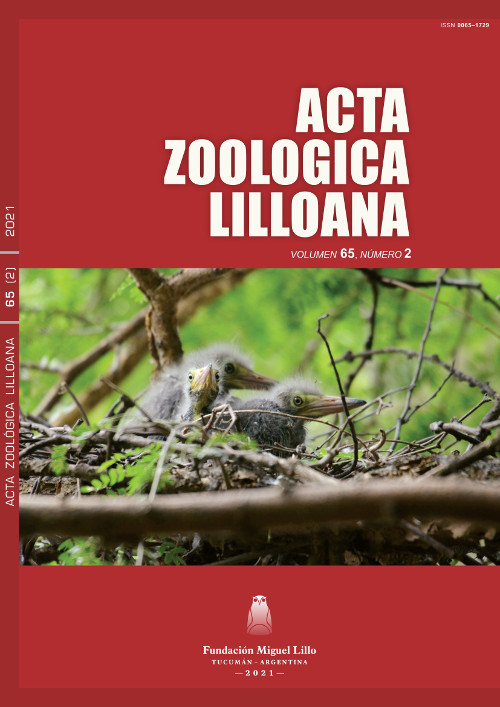Using a sentinel colony of Apis mellifera (Hymenoptera: Apidae) to assess pesticides and food sources.
DOI:
Palavras-chave:
Coumaphos, foraging behavior, honey bee management, pollen, spiridiclophenResumo
Honey bee populations are declining as occurs with other pollinators. One suggested cause of this decline is the impact of pesticides. To improve bees’ health, pesticides and food sources may be monitored using sentinel hives, given that bees forage in a 2.5 km radius around the hive. We extracted 20 (twenty) bees, as well as samples of wax, honey and pollen from a sentinel hive. Six pesticides were detected in the samples, except for the honey. All detected pesticides in the sentinel hive are pro- hibited in Argentina. Eight different plant families and genera were detected in the honey and pollen samples. Our work suggests that monitoring pesticides with sentinel beehives will be useful to improve agricultural practices in the region.
Downloads
Referências
Ayup, M. M., Gärtner, P., Agosto-Rivera, J. L., Marendy, P., de Souza, P., Galindo Cardona, A. (2021). Analysis of Honeybee Drone Activity during the Mating Season in Northwestern Argentina. Insects, 12, 566. https://doi.org/10.3390/insects12060566
Chalup, A., Ayup, M. M., Monmany Garzia, A. C., Malizia, A., Martin, E., De Cristobal, R., Galindo-Cardona, A. (2018). First report of the lesser wax moth Achroia grisella F. (Lepidoptera: Pyralidae) consuming polyethylene (silo-bag) in northwestern Argentina. Journal of Apicultural Research, 57, 569–571. doi:
1080/00218839.2018.1484614.
Couvillon, M. J., Riddell Pearce, F. C., Accleton, C. Fensome, K. A. Quah, S., Taylor, E. L., Ratnieks, F. (2015). Honey bee foraging distance depends on month and forage type. Apidologie, 46, 61–70. https://doi.org/10.1007/s13592-014-0302-5
Enviromental Protection Authority. (2018). Science memo for the reassessment of the approval to import or manufacture Luna Sensation for release (APP203261). pp: 27.
Gallo Mendoza, G. (2006). Agroquímicos prohibidos o restringidos: Normas Reguladoras de Procedimientos para evitar la contaminación. PRAT-DNAyF-SSAGyF-SAGPyA-ME.(http://www.alimentosargentinos.gob.ar/bpa/bibliografia/Minagro_Agroquimicos_prohibidos.pdf).
García, M. D. G., Duque, S. U., Fernandez, A. B. L., Sosa, A., Fernandez-Alba, A. R. (2017). Multiresidue method for trace pesticide analysis in honeybee wax comb by GC-QqQ-MS. Talanta 163, 54–64.
Gregorc, A., Alburaki, M., Rinderer, N., Sampson, B., Knight, R. P., Karim, S., Adamczyk, J. (2018). Effects of coumaphos and imidacloprid on honey bee (Hymenoptera: Apidae) lifespan and antioxidant gene regulations in laboratory experiments. Scientific Reports, 8, 15003.
Herrera López, S., Lozano, A., Sosa, A., Hernando, M. D., Fernández-Alba, A. R. (2016). Screening of pesticide residues in honeybee wax comb by LC-ESI-MS/MS. A pilot study. Chemosphere.
https://doi.org/10.1016/j.chemosphere.2016.07.008
Imtrade Australia. Imtrade Carbendazim 500SC Fungicide. Safety data sheet. (2014). pp: 5.
Intergovernmental Science-Policy Platform on Biodiversity and Ecosystem Services
(IPBES). (2016). The assessment report on pollinators, pollination and food prodution. pp 152-188.
IUPAC. Pyraclostrobin (Ref: BAS 500F). (2021).
Kochansky, J., Wilzer, K., Feldlaufer, M. (2001). Comparison of the transfer of coumaphos from beeswax into syrup and honey. Apidology 32, 119-125.
Mao, W., Schuler, M. A. Berenbaum, M. R. (2013). Honey constituents up-regulate honey bee genes. Proceedings of the National Academy of Sciences of the United States of America. 110, 8842-8846.
Minnesota Department of Agriculture. https://www.mda.state.mn.us/protecting/bmps/pollinators/beetoxicity
Niell, S., Jesús, F., Pérez, N., Pérez, C., Pareja, L., Abbate, S., Carrasco Letelier, L., Díaz, S., Mendoza, Y., Cesio, V., Heinzen, H. (2017). Neonicotinoids transference from the field to the hive by honey bees: Towards a pesticide residues biomonitor. Science of Total Environment 581–582, 25–31.
Poquet, Y., Vidau, C., Alaux, C. (2016). Modulation of pesticide response in honeybees. Apidologie 47, 412–426. https://doi.org/10.1007/s13592-016-0429-7
Porrini, C., Mutinelli, F., Bortolotti, L., Granato, A., Laurenson, L., Roberts, K., Gallina, A., Silvester, N., Medrzycki, P., Renzi, T., Sgolastra, F. & Lodesani, M. (2016). The Status of Honey Bee Health in Italy: Results from the Nationwide Bee Monitoring Network. PLoS ONE 11, e0155411. https://doi.org/10.1371/
journal.pone.0155411
Requier, F., Antúnez, K., Morales, C., Aldea Sánchez, P., Castilhos, D., Garrido, P., Giacobino, A., Reynaldi, F., Rosso Londoño, M., Santos, E., Garibaldi, L. (2018) Trends in beekeeping and honey bee colony losses in Latin America, Journal of Apicultural Research, 57:5, 657-662, DOI: 10.1080/00218839.2018.1494919
Smart, D. M., Pettis, S. J., Eulis, N., Spivak, S. M. (2016). Land use in the North Great Plains region of the U.S. influences the survival and productivity of honey bee colonies. Agriculture, Ecosystems and Environment 230, 139-149.
Traynor, K., Pettis, J., Tarpy, D. R., Mullin, A. C., Frazier, L. J., Frazier, M., vanEngelsdorp, D. (2016). In-hive Pesticide Exposome: Assessing risks to migratory honey bees from in-hive pesticide contamination in the Eastern United States. Scientific Reports 6, 33207. https://doi.org/10.1038/srep33207
UNIVERSAL Crop Protection (Pty) Ltd. Material safety data sheet. Universal ametryn 500sc. (2015). pp: 3.
Van der Steen, J. J., de Kraker, J., Grotenhuis, T. (2015). Assessment of the potential
of honeybees (Apis mellifera L.) in biomonitoring of air pollution by cadmium,
lead and vanadium. Journal of Environmental Protection, 6, 96.
Vázquez, D. E., Balbuena, M. S., Chaves, F., Gora, J., Menzel, R., Farina, W. M. (2020). Sleep in honey bees is affected by the herbicide glyphosate. Scientific Reports, 10, 1-8.
Williamson, S. M., Wright, G. A. (2013). Exposure to multiple cholinergic pesticides impairs olfactory learning and memory in honeybees. Journal of Experimental Biology, 216, 1799–1807.
Downloads
Publicado
Como Citar
Edição
Seção
Licença
Copyright (c) 2021 Acta Zoológica Lilloana

Este trabalho está licenciado sob uma licença Creative Commons Attribution-NonCommercial-NoDerivatives 4.0 International License.









